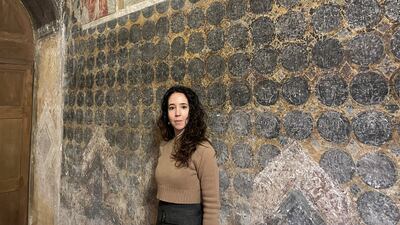Medieval churches may have used Islamic tents to conceal a sacred area where prayers, communion, weddings and other rituals took place, according to a study of a 13th-century fresco painting discovered in a church in Italy.
Researchers say the painting in the town of Ferrara almost certainly depicts a real tent, which was brightly coloured and covered in jewels and used to hide the altar when not in use.
It is believed the real tent was at one time probably present in the church – brackets and nails have been found which could have been used to hang it in the area where the fresco was painted, known as the apse, which is a high semi-circular dome bay which houses the altar.
Experts think it may either have been a gift from a Muslim leader; a trophy seized from the battlefield; or even a present from Pope Innocent IV – who donated several precious textiles to the Benedictine convent church of S. Antonio in Polesine, Ferrara, where the fresco was painted.
The 700-year-old fresco is thought to be the only surviving image of its kind, offering evidence of a little-known, but possibly common, Christian practice.
Cambridge University historian Dr Federica Gigante first came across the fresco early in her career more than a decade ago in her hometown. And although she suspected it was of an Islamic tent at the time, she quickly dismissed the idea, returning to it years later with more experience, by which point she was convinced by what she had found.
“I presented it at a few conferences thinking this will be the perfect venue. Someone will certainly raise their hand and say I have seen something similar,” she told The National.
“That didn’t happen, so I got to a point where I thought I haven’t found any examples yet, even though I have been looking for them for 10 years, if not more.”
But that does not mean that it was the only one, she said. Dr Gigante thinks the practice might actually have been quite common.
“I’m saying that for two reasons, in terms of the textiles, it is organic and would probably have been gone by now,” she said. “The only circumstances in which Islamic textiles in churches survived was when they were wrapping relics. And there are plenty of fragments in museums because these were originally used to wrap the bone of a saint. And by definition they would have been in airtight containers and untouched for centuries.”
Islamic fabrics were also used during the period in Italy in burials, to cover the bodies of important people, she said. “Kings and nobles would be buried in these textiles because they were beautiful and precious,” she added.
The structure, design and colour scheme of the painted tent closely resemble the few surviving illustrations of Andalusi tents, including in the 13th-century manuscript, the Cantigas de Santa Maria. They also match one of the few potential surviving Andalusi tent fragments, the ‘Fermo chasuble’, which is said to have belonged to St Thomas Becket, Archbishop of Canterbury.
A band with Arabic-like inscriptions runs along the edge of the top and bottom border. The textile also features white contours to emphasise contrasting colours reflecting a trend in 13th-century Andalusi silk design.
Other elements include the fresco’s painted “fabric”, which features blue eight-pointed star motifs and parts originally painted in gold leaf, exactly like the golden fabrics used for valuable Islamic tents. The jewels depicted in the fresco are also similar to a rare surviving jewelled textile made by Arab craftsmen, the mantle of the Norman King Roger II of Sicily (1095–1154), which was embroidered with gold and applied with pearls, gemstones and cloisonné enamel.
“The artist put a lot of effort into making the textile appear lifelike,” said Dr Gigante.
More from Neighbourhood Watch:
UAE%20athletes%20heading%20to%20Paris%202024
%3Cp%3E%3Cstrong%3EEquestrian%3C%2Fstrong%3E%3Cbr%3EAbdullah%20Humaid%20Al%20Muhairi%2C%20Abdullah%20Al%20Marri%2C%20Omar%20Al%20Marzooqi%2C%20Salem%20Al%20Suwaidi%2C%20and%20Ali%20Al%20Karbi%20(four%20to%20be%20selected).%3Cbr%3E%3Cstrong%3EJudo%3C%2Fstrong%3E%3Cbr%3EMen%3A%20Narmandakh%20Bayanmunkh%20(66kg)%2C%20Nugzari%20Tatalashvili%20(81kg)%2C%20Aram%20Grigorian%20(90kg)%2C%20Dzhafar%20Kostoev%20(100kg)%2C%20Magomedomar%20Magomedomarov%20(%2B100kg)%3B%20women's%20Khorloodoi%20Bishrelt%20(52kg).%3Cbr%3E%3Cbr%3E%3Cstrong%3ECycling%3C%2Fstrong%3E%3Cbr%3ESafia%20Al%20Sayegh%20(women's%20road%20race).%3Cbr%3E%3Cbr%3E%3Cstrong%3ESwimming%3C%2Fstrong%3E%3Cbr%3EMen%3A%20Yousef%20Rashid%20Al%20Matroushi%20(100m%20freestyle)%3B%20women%3A%20Maha%20Abdullah%20Al%20Shehi%20(200m%20freestyle).%3Cbr%3E%3Cbr%3E%3Cstrong%3EAthletics%3C%2Fstrong%3E%3Cbr%3EMaryam%20Mohammed%20Al%20Farsi%20(women's%20100%20metres).%3C%2Fp%3E%0A
The specs
Engine: 4.0-litre V8 twin-turbocharged and three electric motors
Power: Combined output 920hp
Torque: 730Nm at 4,000-7,000rpm
Transmission: 8-speed dual-clutch automatic
Fuel consumption: 11.2L/100km
On sale: Now, deliveries expected later in 2025
Price: expected to start at Dh1,432,000
Jetour T1 specs
Engine: 2-litre turbocharged
Power: 254hp
Torque: 390Nm
Price: From Dh126,000
Available: Now
Company Profile
Name: JustClean
Based: Kuwait with offices in other GCC countries
Launch year: 2016
Number of employees: 130
Sector: online laundry service
Funding: $12.9m from Kuwait-based Faith Capital Holding
Wicked: For Good
Director: Jon M Chu
Starring: Ariana Grande, Cynthia Erivo, Jonathan Bailey, Jeff Goldblum, Michelle Yeoh, Ethan Slater
Rating: 4/5
Key features of new policy
Pupils to learn coding and other vocational skills from Grade 6
Exams to test critical thinking and application of knowledge
A new National Assessment Centre, PARAKH (Performance, Assessment, Review and Analysis for Holistic Development) will form the standard for schools
Schools to implement online system to encouraging transparency and accountability
Company%20profile
%3Cp%3E%3Cstrong%3ECompany%20name%3A%20%3C%2Fstrong%3EHakbah%0D%3Cbr%3E%3Cstrong%3EStarted%3A%20%3C%2Fstrong%3E2018%0D%3Cbr%3E%3Cstrong%3EFounder%3A%20%3C%2Fstrong%3ENaif%20AbuSaida%0D%3Cbr%3E%3Cstrong%3EBased%3A%20%3C%2Fstrong%3ESaudi%20Arabia%0D%3Cbr%3E%3Cstrong%3ESector%3A%20%3C%2Fstrong%3EFinTech%0D%3Cbr%3E%3Cstrong%3ECurrent%20number%20of%20staff%3A%20%3C%2Fstrong%3E22%20%0D%3Cbr%3E%3Cstrong%3EInitial%20investment%3A%20%3C%2Fstrong%3E%24200%2C000%0D%3Cbr%3E%3Cstrong%3EInvestment%20stage%3A%20%3C%2Fstrong%3Epre-Series%20A%0D%3Cbr%3E%3Cstrong%3EInvestors%3A%20%3C%2Fstrong%3EGlobal%20Ventures%20and%20Aditum%20Investment%20Management%0D%3Cbr%3E%3Cbr%3E%3C%2Fp%3E%0A
More from Janine di Giovanni
Defence review at a glance
• Increase defence spending to 2.5% of GDP by 2027 but given “turbulent times it may be necessary to go faster”
• Prioritise a shift towards working with AI and autonomous systems
• Invest in the resilience of military space systems.
• Number of active reserves should be increased by 20%
• More F-35 fighter jets required in the next decade
• New “hybrid Navy” with AUKUS submarines and autonomous vessels
Armies of Sand
By Kenneth Pollack (Oxford University Press)
White hydrogen: Naturally occurring hydrogen
Chromite: Hard, metallic mineral containing iron oxide and chromium oxide
Ultramafic rocks: Dark-coloured rocks rich in magnesium or iron with very low silica content
Ophiolite: A section of the earth’s crust, which is oceanic in nature that has since been uplifted and exposed on land
Olivine: A commonly occurring magnesium iron silicate mineral that derives its name for its olive-green yellow-green colour



